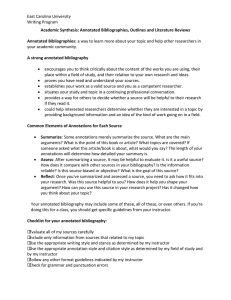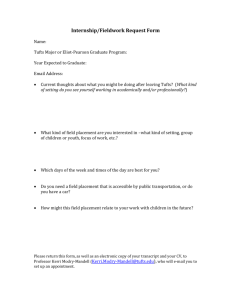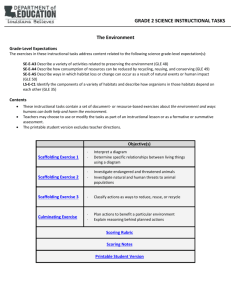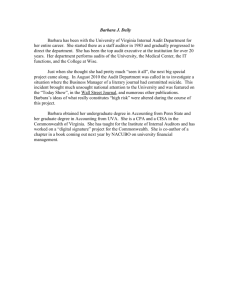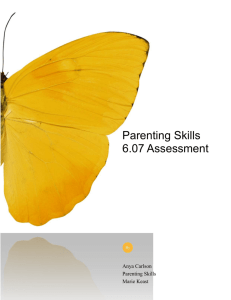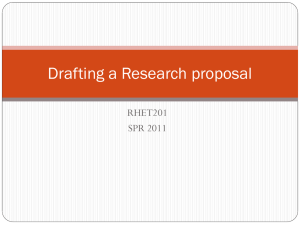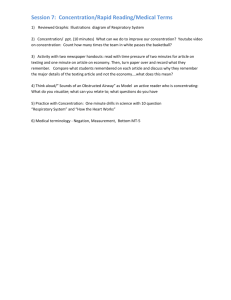Academic Synthesis
advertisement
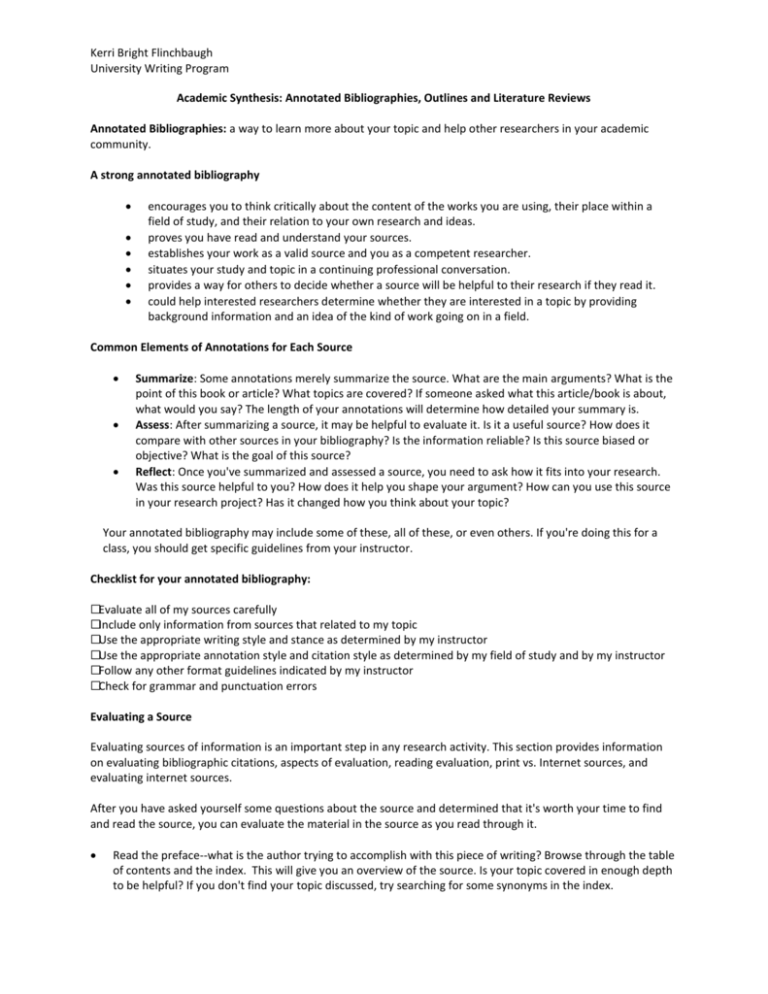
Kerri Bright Flinchbaugh University Writing Program Academic Synthesis: Annotated Bibliographies, Outlines and Literature Reviews Annotated Bibliographies: a way to learn more about your topic and help other researchers in your academic community. A strong annotated bibliography encourages you to think critically about the content of the works you are using, their place within a field of study, and their relation to your own research and ideas. proves you have read and understand your sources. establishes your work as a valid source and you as a competent researcher. situates your study and topic in a continuing professional conversation. provides a way for others to decide whether a source will be helpful to their research if they read it. could help interested researchers determine whether they are interested in a topic by providing background information and an idea of the kind of work going on in a field. Common Elements of Annotations for Each Source Summarize: Some annotations merely summarize the source. What are the main arguments? What is the point of this book or article? What topics are covered? If someone asked what this article/book is about, what would you say? The length of your annotations will determine how detailed your summary is. Assess: After summarizing a source, it may be helpful to evaluate it. Is it a useful source? How does it compare with other sources in your bibliography? Is the information reliable? Is this source biased or objective? What is the goal of this source? Reflect: Once you've summarized and assessed a source, you need to ask how it fits into your research. Was this source helpful to you? How does it help you shape your argument? How can you use this source in your research project? Has it changed how you think about your topic? Your annotated bibliography may include some of these, all of these, or even others. If you're doing this for a class, you should get specific guidelines from your instructor. Checklist for your annotated bibliography: ☐Evaluate all of my sources carefully ☐Include only information from sources that related to my topic ☐Use the appropriate writing style and stance as determined by my instructor ☐Use the appropriate annotation style and citation style as determined by my field of study and by my instructor ☐Follow any other format guidelines indicated by my instructor ☐Check for grammar and punctuation errors Evaluating a Source Evaluating sources of information is an important step in any research activity. This section provides information on evaluating bibliographic citations, aspects of evaluation, reading evaluation, print vs. Internet sources, and evaluating internet sources. After you have asked yourself some questions about the source and determined that it's worth your time to find and read the source, you can evaluate the material in the source as you read through it. Read the preface--what is the author trying to accomplish with this piece of writing? Browse through the table of contents and the index. This will give you an overview of the source. Is your topic covered in enough depth to be helpful? If you don't find your topic discussed, try searching for some synonyms in the index. Kerri Bright Flinchbaugh University Writing Program Check for a list of references or other citations that look as if they will lead you to related material that would be good sources. Determine the intended audience. Are you the intended audience? Consider the tone, style, level of information, and assumptions the author makes about the reader. Are they appropriate for your needs? Try to determine if the content of the source is fact, opinion, or propaganda. If you think the source is offering facts, are the sources for those facts clearly indicated? Do you think there's enough evidence offered? Is the coverage comprehensive? (As you learn more and more about your topic, you will notice that this gets easier as you become more of an expert.) Is the language objective or emotional? Are there broad generalizations that overstate or oversimplify the matter? Does the author use a good mix of primary and secondary sources for information? If the source is opinion, does the author offer sound reasons for adopting that stance? (Consider again those questions about the author. Is this person reputable?) Check for accuracy. How timely is the source? Is the source 20 years out of date? Some information becomes dated when new research is available, but other older sources of information can be quite sound 50 or 100 years later. Do some cross-checking. Can you find some of the same information given elsewhere? How credible is the author? If the document is anonymous, what do you know about the organization? Are there vague or sweeping generalizations that aren't backed up with evidence? Are arguments very one-sided with no acknowledgement of other viewpoints? Incorporating Others’ Ideas in Your Paper Quotations must be identical to the original, using a narrow segment of the source. They must match the source document word for word and must be attributed to the original author. Paraphrasing involves putting a passage from source material into your own words. A paraphrase must also be attributed to the original source. Paraphrased material is usually shorter than the original passage, taking a somewhat broader segment of the source and condensing it slightly. Summarizing involves putting the main idea(s) into your own words, including only the main point(s). Once again, it is necessary to attribute summarized ideas to the original source. Summaries are significantly shorter than the original and take a broad overview of the source material. On Summarizing, Paraphrasing, and Quoting Read the entire text, noting the key points and main ideas. Summarize in your own words what the single main idea of the essay is. Paraphrase important supporting points that come up in the essay. Consider any words, phrases, or brief passages that you believe should be quoted directly. Six Steps to Effective Paraphrasing 1. Reread the original passage until you understand its full meaning. 2. Set the original aside, and write your paraphrase on a note card. 3. Jot down a few words below your paraphrase to remind you later how you envision using this material. At the top of the note card, write a key word or phrase to indicate the subject of your paraphrase. 4. Check your rendition with the original to make sure that your version accurately expresses all the essential information in a new form. 5. Use quotation marks to identify any unique term or phraseology you have borrowed exactly from the source. 6. Record the source (including the page) on your note card so that you can credit it easily if you decide to incorporate the material into your paper. Kerri Bright Flinchbaugh University Writing Program Constructing an Outline An outline is a tool writers use to organize and examine their thoughts prior to writing them in draft form. Think of it as a map, or blueprint for your paper. Four Steps 1. Identify the topic and purpose. Try to sum up the point of your paper in one sentence or phrase. This will help your paper stay focused on the main point. Also, identify what you are trying to achieve with this paper. Is it persuasive, descriptive, informative…? 2. Brainstorm a list of all the ideas you may want to include in your paper. 3. Organize related ideas into main categories. What main points will you cover? After you identified these categories, arrange material in subsections. Example: General to specific. Or abstract to concrete. 4. Label main and subheadings. Four Main Components 1. Parallelism Each heading and subheading should preserve parallel structure. If the first heading is a verb, the second heading should be a verb. Example: I. CHOOSE DESIRED COLLEGES II. PREPARE APPLICATION ("Choose" and "Prepare" are both verbs. The form for an outline.) 2. Coordination All the information contained in Heading 1 should have the same significance as the information contained in Heading 2. The same goes for the subheadings (which should be less significant than the headings). Example: I. VISIT AND EVALUATE COLLEGE CAMPUSES II. VISIT AND EVALUATE COLLEGE WEBSITES (Campus and websites visits are equally significant. They are part of the main tasks you would need to do. Finding statistics and classes found on college websites are parts of the process involved in carrying out the main heading topics.) 3. Subordination The information in the headings should be more general, while the information in the subheadings should be more specific. Example: I. DESCRIBE AN INFLUENTIAL PERSON IN YOUR LIFE A. Favorite high school teacher B. Grandparent (A favorite teacher and grandparent are specific examples from the generalized category of influential people in your life.) 4. Division Each heading should be divided into 2 or more parts. Example: 1. COMPILE RÉSUMÉ 1. List relevant coursework 2. List work experience 3. List volunteer experience (The heading "Compile Résumé" is divided into 3 parts.) Technically, there is no limit to the number of subdivisions for your headings; however, if you seem to have a lot, it may be useful to see if some of the parts can be combined. Kerri Bright Flinchbaugh University Writing Program Synthesis of Ideas: Literature Review The Dinner Party Research Conversation 1. You are hosting a dinner party for the authors listed in your annotated bibliography and a representative member of your primary audience. If you know you’re composing for a specific journal, you might want to invite the editor. You and the editor will sit across the table from each other, as this conversation is primarily between the two of you; however, you’ll need your guests to speak up on behalf of the research argument you are trying to build. Every good host knows you must seat the right people beside each other, so figure out who could converse with whom (which authors are talking about the same theme, method, concept, approach, etc.), and arrange your authors accordingly. 2. Draw some circles around guests or arrows between those who would likely engage each other in side conversations. What would they talk about? Use some keywords to indicate these themes, methods, methodologies, studies, concepts, approaches, etc. and/or create some symbols (drinks, food items, etc.) with a key. 3. Now you’ll imagine and compose the dialogue that would likely happen over dinner. Your job is to start the conversation with your primary audience member and let others naturally jump when they can productively contribute to the dialogue. By the end of the dialogue, you should have reasonably convinced your audience member of the purpose of your research project, and the last line of dialogue should be from that audience member, indicating his or her assent. 4. Have fun and remember that you are the host– don’t let any one guest take over YOUR conversation. Kerri Bright Flinchbaugh University Writing Program First Annual Archival Potluck Dinner Dinner guests: Barbara L’Eplattenier, Robert Connors, Will Banks, Cheryl Glenn, Kerri Flinchbaugh Setting: A large wooden table with a low-lit, low-hanging, art deco chandelier above. The table setting is simple but elegant. A few low, tapered candles sit among a small arrangement of wildflowers in the center. The fresh green salad with roasted pears and several of the “good” of cheeses that Barbara brought in a lovely cobalt bowl sits on the sidelines, now more than half empty. Cheryl’s pasta pesto with local, heirloom tomatoes is currently the focus of most people’s attention. And Robert’s bottle of Radison, Merlot (2000) only has a ring of burgundy left at the bottom. Kerri brought the bread. Barbara (smiling warmly): Banksie, I can’t wait for the raspberry tart you brought for dessert. How is Wendy doing? Will: She’s good. Good, but busy. With the QEP and all… Robert: Oh, yes. Your writing QEP. Are you starting in the archives with that? Will: We will get there. One aspect of the QEP is creating an archive of student writing in e-portfolios. We will see where it goes from there. You know how it goes, Dr. Bob. (smiling, joking) This is the work part. We will get to the playing later. Cheryl: Taking into account the remapping activities of our discipline, the possibilities are endless with these student portfolios. [pause] I am interested to see how you will complicate the reading of the students’ writings. Have you considered the lens from which your readers will be examining the student writing? Which will provide the richest, fullest picture? [No response. Thinking.] Kerri: I have actually been wondering lately if Bob Broad’s ideas on Dynamic Criteria Mapping could be a useful tool in the historiographical, feminist, and gender methods offered by Bizzlle, Cheryl. And also in the role DCM could possibly play in the QEP. Will (smiling knowingly): All good assessment is organic, local, and formative. Cheryl: I’m not quite seeing how DCM would fit in with Bizzle’s angles… I don't see my work and assessment...seems like apples and oranges, possibly. Kerri: I was just wondering if DCM could be a tool in helping us figure out, help us identify what we value within our angles. What are our values and our lens’s values? Cheryl: Perhaps… Barbara (abruptly, but not harshly, turning her attention): Dr. Bob, I honestly have a little bone to pick with you. This playing in the achieves business… Don’t you think that makes the whole process of archival research a little too… mystical? Robert (curious but playful): Mystical? Barbara: Silly? Robert: Silly? Barbara: Unclear. I mean, “a mushroom hunt”?! (chuckles all around) Robert: Well, honestly Barbara, I had a question for you also. This addition of a methods section in our archival Kerri Bright Flinchbaugh University Writing Program research products… I noticed in your list of reasons of why this is such a great idea that there is no mention of the greater implications, outside of composition and rhetoric. Isn’t it the stories that are what is important in our research? This addition of methods… It’s tilting at windmills… Attempting to deconstruct epistemic certainties that may be better left intact. (smiling, chuckling) “I will friend you, if I may.” If not,… oh well! (smiles) We still have our stories. [thoughtful quietness] Besides, couldn’t adding such a section be viewed as a mere attempt to conform to the quantitative, scientific disciplines? Just an attempt to make ourselves more “reliable” or more “valid” in some way? Will: What’s the difference? We’re not writing for them anyway, why should their interpretations be our priority? If they see it as more valuable, so what? If not… oh well. What is the value and purpose in it for us? Our students? Cheryl: I see where Barb is coming from. I will be the first to point out - in my very postmodern way - that we do all have angles, and they do make us skeptical about the procedures that legitimized and mapped out the history of rhetoric in the first place. Will: Okay. Who wants raspberry tart?
